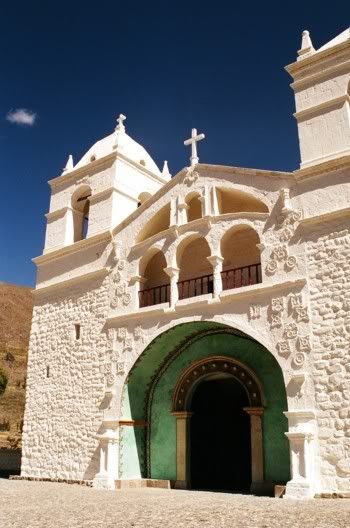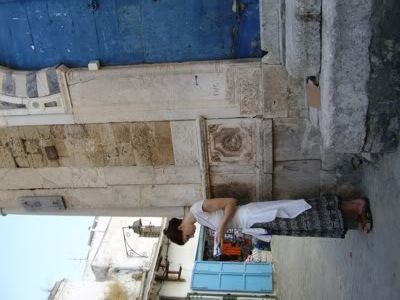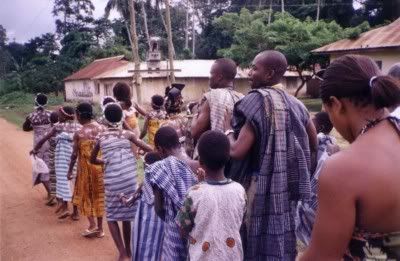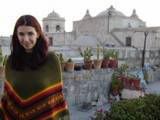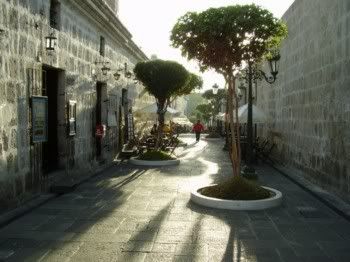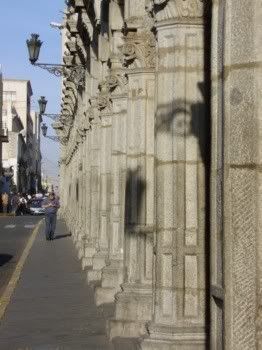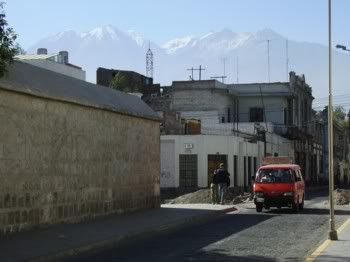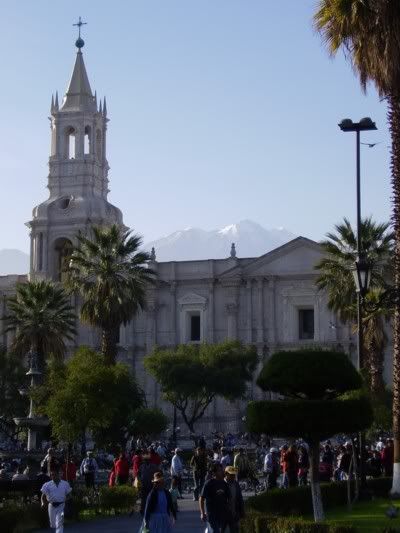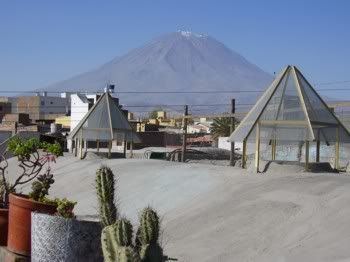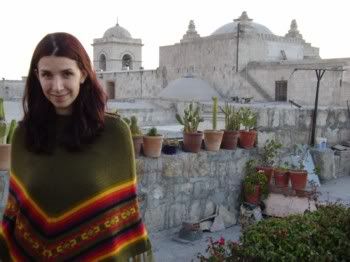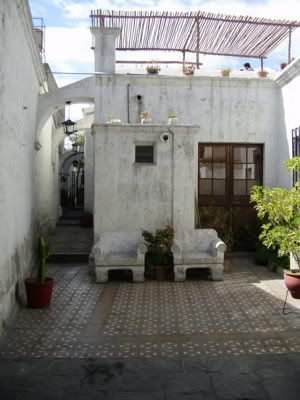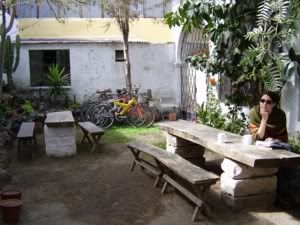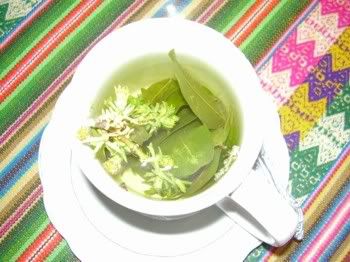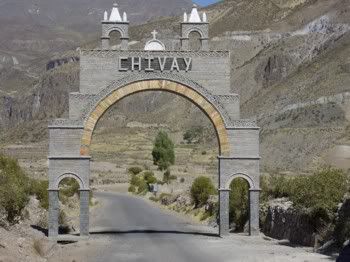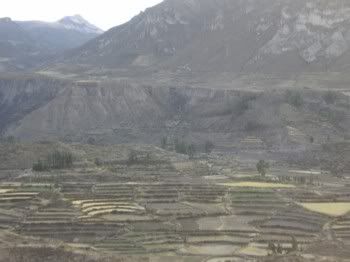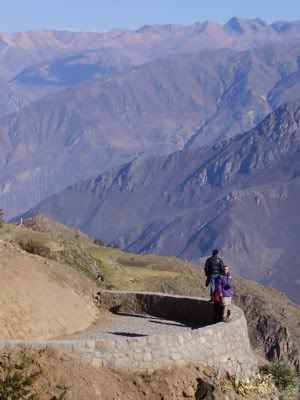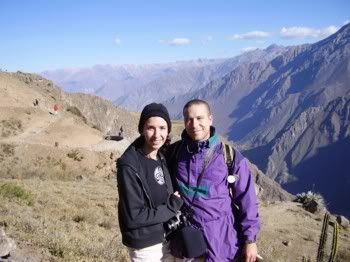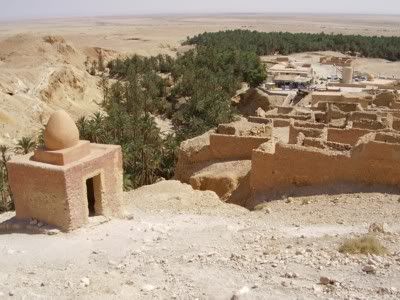 Dusty:Starlight:Culture
|
|
|
|
the word from the road
2005-08-21 11:38 p.m. Before the rush and vomitrotious (I'm an academic, we're allowed to make up words) pace of the fall semester begins, I've been occupying myself by and when 1) and 2) get too pretentious even for me, I work on 3) Transferring journal pages from our Peru trip into more narrative, readable computer files. ...excerpts of which will follow here with appropriate pictures. Enjoy, or send me hate mail: ariadnes_legacy@yahoo.com xoxo * Arequipa The Andes stretch miles high above urbano dwellers down below, and form cool and damp cloud cities that even on the chilliest of nights manage to resolve themselves with sunshine the next day. They are an advertising agency's dream, a new-wave music Album cover, a National Geographic photo op. Colors are vibrant, and the sheer drops and steep passes are as breath-taking as the thin air. Arequipa is the Sillar city, all colonial buildings and infrastructure being built out of the sparkly white volcanic rock. Our nights have been spent inside an old mansion with a large open courtyard and trees growing up through the roof and peeking out onto the terrace above. Days have been spent peering into old monasteries, lurking in vegetarian cafes to watch all the on-the-road, backpacker romances brewing, and to seek out any smidgen of English speaking we can find. I remembered, slowly, to replace the images I conjure when I hear the word city. This is a third world city, with dirt-pack roads, low buildings, a supermarket or two and some gas stations. It's so easy to forget that city doesn't have to mean smog and sky-scrapers. It's the kind of city I could live in, maybe even thrive in, given the right mix of people. The mix of people has been absolutely volatile here in this last week, though; there were three political demonstrations over the last two days here, one that became an outright riot that closed roads and blocked up traffic for hours. I was happy to be jolted out of the political lull my own country seems to have fallen into, letting celebrity news distract us from poor choices, soaring unemployment and gas prices, and a treasonous presidential administrative leak that endangered the lives of our own agents. Here, people demand to be heard, voting is compulsory, and even the illiterate pay attention to who is running their country and what decisions they're making. Unfortunately for the Peruvians, who have had about 34 presidents in the last 37 years, the government typically makes bad decisions or gets themselves involved in other countries' politics, often getting the bum end of whatever deal is struck (and we in the US have been some of the worst offenders, believe me), which of course effects the working people most directly. Arequipa and Arequipenos are funny, probably for that reason - they've tried several times to emancipate themselves from the country, and declare themselves and independent city-state. There's quite a sense of pride in Arequipa - and, just as French Canadians will say "QUEBEC" quite firmly when you say "Where are you from?", Arequipenos will say "Arequipa" before they say "Peru". I can suddenly understand that, though - I'm quick to point out the specific location of my home within the US after this last election. If you think people in the Northeast/West Coast (& other isolated pockets, fine) are seething with rage and frustration over the current administration, stepping outside the country and talking to citizens there will make us look tolerant. I want to communicate in the least offensive way that I'm on their side. So a city I could get used to is what I see before me. Even still, we feel the need to push through and ahead, even after a few days pass, and find ourselves in Chivay, a base from which we will trek out into Colca Canyon. Chivay So what's in Chivay? Absolutely nothing, save for a village school, some farms, a marcado, a teeny Plaza de Armas with a colonial church, and a few restaurants. Oh yes, and an Irish pub called McFarley's. They really are everywhere. Getting here was a bit of a feat; I guess we should have researched a bit more before we took the trip, but here we are. We hopped a bus this morning around 8, the Colonial House Inn nice enough to keep our big packs until we return in a few days. We both nodded off in our seats but woke up, respectively, when we felt the bus start a sharp ascend that didn't really seem to stop. I looked out the window and wished I didn't; a sheer cliff dropped 300 meters below, and, well, it's Peru, so guard-rails, shmard-rails. I did see a number of crosses and flowers on what little there was of a shoulder, the kind that people pile up when someone has driven over the edge and plunged to their death. I do believe they close these mountain roads at night, and I'm suddenly thrilled that we decided to return on an AM bus and just stick out the two days in the Canyon. I smelled something odd and earthy, and realized the driver in front of us chewing coca leaves. We stopped at a small roadside cafe, and all the passengers, except a dazed us, at first, rushed out to buy cups of coca tea. As I stood up, I realized why - I had to sit right back down again, dizzy from just moving about in my seat. The tea does help - gets your blood moving and eases the headache a bit. After pulling away again and beginning yet another climb, we asked the driver's assistant (first mate?) in mangled Spanish how high we were. He looked out the window, and we followed his gaze, finding nothing but moss, lichen and...is that snow? "4,500 meters, más o menos," he said, a wad of coca leaves in his mouth. We smiled, and pretended to understand the rough translation of meters to feet, our better sense of scale, but then gasped when we looked it up in the guide book's conversion chart. Nearly 15,000 feet! And - aside from momentary (albeit bizarre) tingling in the extremities, slightish headaches, and super dry-mouth - no migraine!. No passing out! No blood gushing from lungs! No cerebral hemorrhaging! Certainly understanding that AMS can strike anytime, even after acclimatization, we still felt like this was a small victory - especially since this altitude is higher than Aguas Calientes, Machu Picchu, and even Puno and Lake Titicaca, places we were somewhat concerned about. Unbeknownst to us, we traveled through what might be our highest point of the trip - something we were saving for the next week. Here, now, in Chivay, we had some - um, I guess you'd call it Pizza - and tried to get some sleep. Walking from the front reception area of the hostel to our room was a bit of a chore - how are we going to hike tomorrow if walking a few meters down a sidewalk is tiring? I guess "slowly" is the answer to that question. Sleeping at Altitude Hopefully this will be of use to someone at some point. Apparently it's perfectly normal when sleeping at about 14,000 feet to: 1)Have REALLY messed up and freaky dreams. And we opted to stay away from Lariam on this trip again, specifically for that reason. Go figure. Steve's dream involved being trapped in a most unsanitary and dank mental hospital, and mine involved a car running over two toddlers while I was in the passenger seat. Awful, awful. 2)Wake up - as in wide-a-fucking-wake - 8-10 times throughout the night. 3)Sweat profusely, even though at that altitude it's likely to be cold (it was about 25F for us) wherever you are in the world. and finally -and this is the scariest- 4)Hyperventilate in your sleep. The pattern goes like this: 8-10 seconds, no breath. The next few seconds: breath breath breath breath breath, in rapid succession. I woke myself up doing this, and then the next night heard husband stop breathing and got so scared that I woke him up. Doc says this is normal, and so did the Brits we befriended who had been up to Everest two years before. Yek. And this isn't really about sleeping, but waking, but is an important addendum: your nose will most likely bleed at this altitude, even if not bleed-bleed, then just "it's dry air" bleed, on the inside. This blood might drip down into your throat in the night as you sleep or lay reclined, eventually collecting or finding it's way into your mouth. So if you taste/cough up blood (well, teeny flecks of blood in mucous/saliva, or something) in the morning, don't freak. Like I did. In fact, it would be best not to cry and wake up husband at 4:45 in the morning with "Honey, honey! I'm bleeding! I'm bleeding!" The freaky dreams are bad enough without all of that. Colca Canyon Despite the three hours' uneasy sleep and my absolute conniption this morning over what I swore was ulcerated lungs (oh, you know me) but was nothing more than a bloody post-nasal drip (eeew! sorry), we just had the most amazing hike. Steve was a bit dizzy, but I actually felt OK - and got some great pictures. We found a pre-Inca burial site - tombs in a cave, basically - and though most have unfortunately been destroyed by grave robbers, they were still beautiful, in a creepy sort of way, to see. I'm proud of myself for keeping up and also helping Steve when he needed it; I was so afraid it would be me lagging behind, sick, with a migraine, and just being a general dead weight. I feel like a gazelle in my new walkies, and was so happy to get to the canyon's edge before hordes of package tour busses pulled up to watch the condors. Immense things, those birds - outstretched, their wingspan is overwhelmingly large - did someone say 9 feet? I believe it, seeing the scale of the birds as they'd swoop down near people on the edge of a cliff. I do firmly believe a condor could carry away a small human child with little effort. I've never been this high before, nor have I ever hiked anything like Colca canyon. The sun is strong and the people colorful - suspicious of us, a bit, but friendly enough. There are wild llamas and vicunas and alpacas everywhere, and then the condors: they catch the thermals rising from the canyon and don't even have to flap their wings to soar and swoop - they just circle high above the cliffs edge, high above the farming steps carved out in the valleys below. As we descended back into Arequipa, I just have to say again how proud I am of us both - we muscled through the altitude issues and the excessive fatigue and were rewarded with some amazing sights. I can't believe husband was so worried about AMS. Heh heh. (That's funny 'cause it was really all me before we left with piles of medical books on her desk). I sit on the roof of the Colonial House Inn at sunset, now, looking back up at the snow-peaked mountain we just climbed down. El Misti sits behind me, and the Picchu Picchu volcano beyond that. In comparison, the air feels lush and plentiful now, though a few days ago when we arrived in Arequipa we were a bit winded climbing up here to have some tea or just talk. I miss my family, and wish my friends could see this now - so many would appreciate it the way that we do. I only have a little light left to take some pictures. *
Hiking in Colca Canyon
|
||
